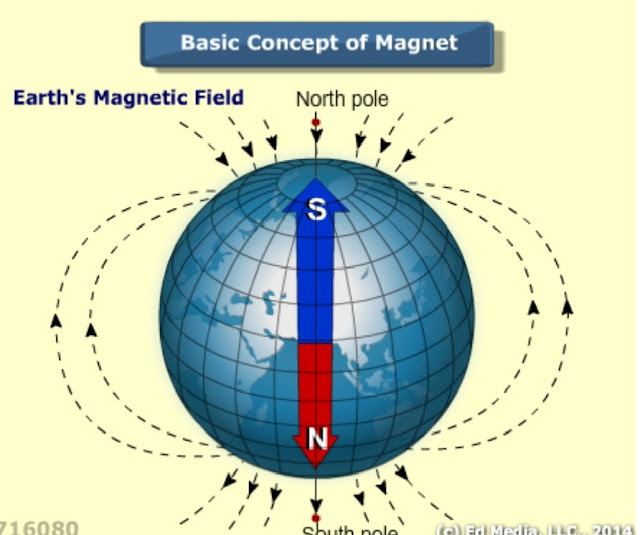ELECTROMAGNETISM, ELECTROMAGNETIC INDUCTION & FARADAY'S LAW
Electromagnetism
Magnetic field
Magnetic field is a lines of force surrounding a permanent
magnet or moving charged particle.
What is magnetic flux?
It is defined as the total number of magnetic lines of force
passing through a specified area in a magnetic field. Unit of magnetic flux is
Weber.
You are aware that when an electric current flows through a
conductor, a magnetic field is setup around the conductor, in the year 1820,
Hans Christian Oersted demonstrated that a current carrying conduct is
associated with a magnetic field. You also know that current flow is due to the
motion of electrons . Here the conductor is static. Electrons are moving and
magnetic field is setup around the conductor. This magnetism is called electro
magnetism.
Electromotive force
Electrons are negatively charged and have potential energy. They
move freely from a point of high energy level to a point of low energy level. There
is driving influence needed to cause the continuous flow of electrons. The driving
influence is termed as the electromotive force i.e. EMF. As name implies, there
is a “motive” in the EMF (electro “motive” force) source. But, it is not
actually a force, since it has no dimension.
Electromagnetic induction
When a magnetic field moves across a static conductor, it
produces an emf along the conductor which causes flow of electrons and thus the
flow of electric current in the conductor. This phenomenon is known as
electromagnetic induction. The deflection is more when the magnet is moved
faster, and less when the magnet is moved slowly.
However, on reversing the magnet (i.e.) South pole pointing
towards the coil , same result are obtained, but current flows in opposite
direction.
The interference made by Faraday's are as follows:
- Whenever there is a relative motion between the coil and the magnet, the galvanometer shows deflection indicating the flow of induced current.
- The deflection is momentary. It lasts so long as there is relative motion between the coil and the magnet.
- The direction of the flow of current changes if the magnet is moved towards the galvanometer and withdrawn from it.
Faraday’s laws
Faraday summarized his findings on Electro Magnetic
Induction into two laws called as faraday’s laws of Electro Magnetic Induction.
Faraday’s First Law
“Whenever the magnetic flux linked with a circuit changes,
an EMF is always induced in it.”
Or
“Whenever a conductor cuts magnetic flux , an EMF is induced
in that conductor.”
Faraday’s Second Law
“The magnitude of the induced EMF is equal to the rate of
change of flux-linkages.
- Whenever there is a change of magnetic flux linked with the circuit, there will be an induced emf and the induced emf will last as long as the changes persists.
- The principle of electromagnetic induction is expressed by faraday’s laws
- The emf induced in the conductor is directly proportional to the rate of change of flux.
- EMF is generated by change of flux linking with the conductor.
Take a conducting wire, horseshoe magnet and galvanometer
Test 1
Connect the galvanometer across the ends of wire
Magnetic field lines are present between the two poles of
the magnet.
Cut the magnetic field by the wire in down direction. Galvanometer
shows deflection in clockwise direction.
What do you mean by deflection? Is it persisting or
temporary?..... the deflection is there only when the wire is moving. Once the
movement stops, the deflection ceases.
Test 2
Move the wire towards upward direction.
You find galvanometer shows temporary deflection only when
the wire is on movement but the galvanometer pointer moves in anticlockwise
direction.
So what we conclude from above??? We see that when the wire
cuts the magnetic field, EMF is induced in the wire causing a current flow
through the wire. Secondly, the direction of current flow in galvanometer
depends on the direction of motion of wire in the magnetic field.
Test 3
Now fix the wire arrangement constant and move the magnet in
upward direction.
Galvanometer again shows temporary deflection in clockwise
direction
Test 4
Now fix the wire arrangement constant and move the magnet in
downward direction.
Galvanometer again shows temporary deflection in anticlockwise
direction.
So what we concludes from above test 3&4??? We see that whether the wire is moved or
field is moved, emf is induced in the wire.
This means that it is only the change in magnetic field
linking with the wire causes the emf to be induced in the wire.
And this concept is established by FARADAY’S.
Now change the position of poles of the magnet. You will
find galvanometer deflects in opposite direction due to change in polarity of
magnet.
Galvanometer deflects temporarily in clockwise or
anticlockwise direction as per movement of conducting wire i.e. upward or
downward.
So we concludes that the direction of deflection changes
when the poles of magnet changes. So the direction of current flow in
galvanometer depends also on the direction of the magnetic field. This concept
was stated by Fleming's in his right hand rule.
so what Fleming's left hand rule says???? you can understand by referring below picture .
Now, tell me how you can increase the magnitude of the
induced emf??
Repeat the four tests but cut the magnetic field with wire
in high velocity. You will find galvanometer will deflects more than in the
previous test . It indicates that the magnitude of induced EMF increases when
the flux change increases. This phenomenon is stated by Faraday’s in his second
law.
So I hope you understood clearly the Faraday's laws and how
EMF is induced in a conductor.
Never forget this concept. These are basics for power
generation through induced EMF in the whole World.











Comments
Post a Comment